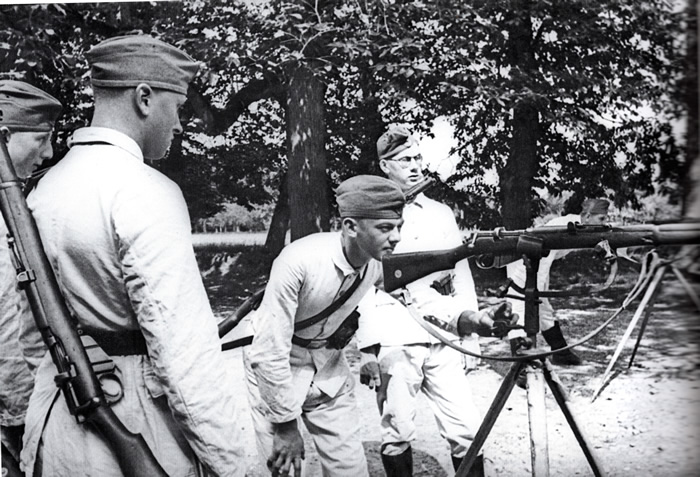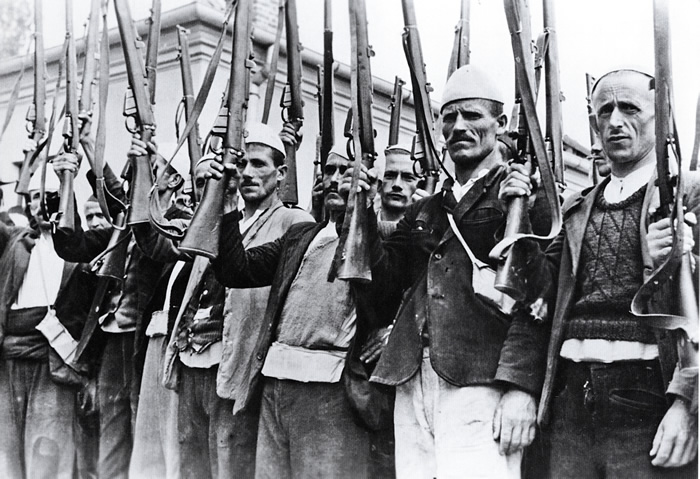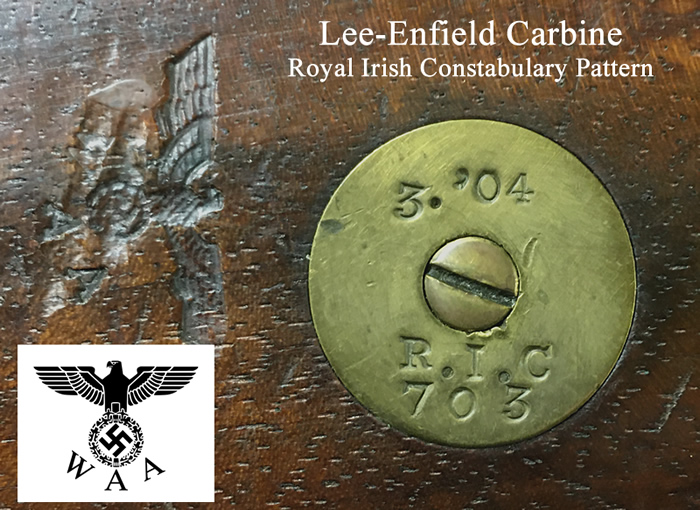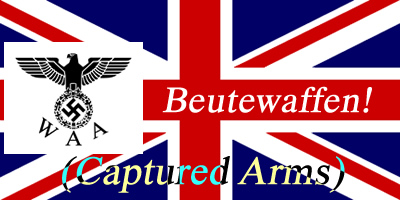Nazi Germany (1933-1945) made extensive use of captured arms (Beutewaffen). Much like the view marks/inspection marks found on British manufactured Lee-Enfield rifles, Nazi Germany made extensive use of inspection/acceptance marks called “Waffenamt” on almost everything used by all branches of German forces – including some captured weapons. [1]
The Waffenamt (WaA) was the German Army Weapons Agency responsible for the testing and acceptance of all weapons, equipment and ammunition before delivery to the Wehrmacht (Defense Force). [02]
The basic WaA symbol is of a Nazi eagle holding a swastika above the letters WaA. The Waffenamt code (WaA followed by a number) is the German inspection proof mark and can be found on firearms and equipment. There were thousands of WaA inspectors. There are also many, many variations of WaA inspection stamps. [03]

Waffenamt can be found on virtually every piece of Nazi-era manufactured equipment, including from factories in Nazi-occupied France, Czechoslovakia, Belgium, Italy and Poland.
The Waffenamt system was intended for manufactured goods – not captured weapons. Nonetheless, over the years many sharp-eyed collectors have reported finding a Waffenamt on Allied small arms, including edged weapons (Blankwaffen).
Over the course of WWII (1939-1945) Nazi Germany captured vast quantities of ammunition and millions of weapons, of which machine guns, such as the Russian PPSh-41 sub-machine gun and the British Mk I Bren, were especially prized by German combat units. [4]
French and Russian bolt-action rifles were captured in the millions. “The Lee-Enfield rifle was by far the most captured British weapon. Contemporary pictures indicate use by regular German and auxiliary units in France, and also by Bosnian volunteers in occupied Yugoslavia.” [5]

Photo credits: Photographer/date/location unknown. Museum of Modern History, Slovenia. Photo number unknown. [6]
Photo notes: Sighting exercises with the Lee-Enfield rifle. The uniforms indicate that these soldiers are Reichsarbeitsdienst (Reich Labour Service, RAD) [7]. The rifle on the stand appears to be an early SMLE (Short Magazine Lee-Enfield) Mk III*. The rifle on far left appears to be a SMLE Mk III. (The magazine cutoff, round cocking knob and recessed sight ears are clearly visible, all indicators of a pre-1915 rifle.)

Photo credits: Photographer unknown; Yugoslavia, 1944. Süddeutsche Zeitung photo number 00095280. [8]
Photo notes: The Yugoslav territory suffered through a multi-sided civil war between Albanians, Croats, Serbians, both monarchist and communists, as well as Slovene units. Pro-German units, such as these Albanian volunteers, were armed to fight Yugoslav anti-German partisans. [9] The rifles are clearly SMLE (Short Magazine Lee-Enfield), probably a mix of Mk III* and Mk III’s. (At least one rifle has a complete volley-sight, which would be correct for a pre-1915 era Mk III rifle.)
The Wehrmacht swept up vast stores of war materials in conquered territories, including semi-obsolete weapons. The Lee-Enfield Carbine (Royal Irish Constabulary Pattern) was basically an obsolete 1890’s six-round cavalry carbine modified to accept a bayonet and then provided to a British/Irish police force, the Royal Irish Constabulary 1903-1904. The RIC was disbanded in 1922 when Ireland became independent of the United Kingdom . [10]
Where the 10,000 RIC carbines went after 1922 is unknown – but at least one of those Irish lads is Beutewaffen marked. [11]

We would like to thank S.I Publicaties BV (The Netherlands) for permission to use two of the the photographs from Captured Arms (Beutewaffen) (The Propaganda Photo Series, Volume IX) by G. de Vries. ISBN 978-90-78521-06-08.
Page Notes & Sources
[1] The Handbook of Military Rifle Marks 1866-1950; An Illustrated Guide to Identifying Military Rifles and Marks, Third Edition. Richard A Hoffman and Noel P. Schott, Mapleleaf Militaria Publications, St. Louis, MO, USA. 2002. UNSPSC-Code : 55101500. ASIN : B00408TVQC Page 27
[2] Wikipedia: Waffenamt https://en.wikipedia.org/wiki/Waffenamt
[3] Photos of Waffenamts courtesy of Vern Bryant and GermanDaggers.com Mr. Bryant has also put together an extensive list of Waffenamt inspection codes. http://www.germandaggers.com/Gallery/WAF.php
[4] Captured Arms (Beutewaffen) (The Propaganda Photo Series, Volume IX). Guus de Vries (Author); published by S.I. Publicaties BV, PO Box 188, 6860 AD Oosterbeek, The Netherlands (2011) www.sipublicaties.nl ISBN-13 : 978-9078521068; 152 pages. Page 05 and 137.
[5] Captured Arms (Beutewaffen); see #4, above. Page 126.
[6] The Museum of Modern History (National Museum of Contemporary History), Slovenia, has an extensive collection of almost 150,000 photographs 1941-1945. http://www.muzej-nz.si/en/collections/fotographic-collections
[7] Wikipedia: Reich Labour Service https://en.wikipedia.org/wiki/Reich_Labour_Service
[8] Süddeutsche Zeitung (German for South German Newspaper), published in Munich, Bavaria, is one of the largest daily newspapers in Germany. Established in 1945, they have an extensive photo archive. Website: https://www.sueddeutsche.de/
[9] Captured Arms (Beutewaffen); see #4, above. Page 131.
[10] Wikipedia: Royal Irish Constabulary https://en.wikipedia.org/wiki/Royal_Irish_Constabulary
[11] We should point out that the WaA markings on this rifle are non-standard. Here we're seeing the full logo/symbol of the WaA, nothing like the typical WaA examples cited. Interestingly, the swastika(s) on the rifle (there are several) appear to have been beaten with a small ballpeen hammer to obliterate the markings.

